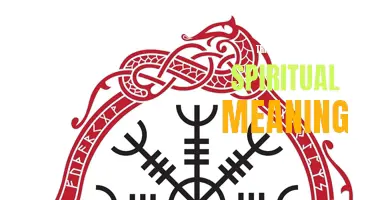
Palm trees, with their towering and graceful presence, have long held a special place in various cultures and religions around the world. Beyond their aesthetic beauty, these magnificent trees hold a deep spiritual significance that traces back centuries. In many traditions, palm trees symbolize triumph, resilience, and enlightenment, as they weather storms and stand tall in the face of adversity. Revered for their ability to provide shelter, sustenance, and even healing properties, palm trees embody a sense of protection, abundance, and sacred energy. Join us as we delve into the diverse spiritual meanings behind palm trees and the profound lessons they can teach us about life and spiritual growth.
What You'll Learn
- What is the symbolic meaning of palm trees in various spiritual and religious traditions?
- How does the symbolism of palm trees relate to growth, resilience, and spiritual enlightenment?
- In what ways do palm trees represent harmony, peace, and a connection to nature in spiritual practices?
- What role do palm trees play in cultural rituals, ceremonies, and traditional practices with spiritual significance?
- Are there any specific palm tree symbols or meanings attributed to different cultures or belief systems?

What is the symbolic meaning of palm trees in various spiritual and religious traditions?
Palm trees are often seen as symbols of vitality, abundance, and spiritual growth in various spiritual and religious traditions across the world. With their tall and graceful trunks, lush green leaves, and delicious fruits, these majestic trees hold a special place in the hearts and minds of many cultures.
In Christianity, palm trees hold immense symbolism. They are mentioned numerous times in the Bible, particularly in the Old Testament. In the Book of Exodus, for example, the Israelites find palm trees when they reach Elim after their escape from Egypt. These trees are seen as a symbol of rest and provision after a period of hardship. Additionally, palm branches were used during the festival of Sukkot to construct temporary shelters, representing the Israelites' reliance on God for protection and sustenance. In the New Testament, palm branches are mentioned during Jesus' triumphant entry into Jerusalem, where they are waved by the crowds as a sign of celebration and victory.
In Hinduism, the palm tree, known as the Kalpavrisksha, is considered a sacred tree that fulfills all desires. It is often depicted in artwork and is associated with fertility, regeneration, and immortality. The coconut, a fruit of the palm tree, is used in various rituals and offerings. It is believed to represent divine consciousness and is broken as an act of surrender and sacrifice.
In Buddhism, the palm tree is highly revered as a symbol of enlightenment. The tree is said to have appeared miraculously before Gautama Buddha's birth to support his mother, Queen Maya, during labor. After his birth, he took seven steps and proclaimed his enlightenment. The palm tree held great significance in this event, representing stability and endurance. It is often depicted in Buddhist art as the Bodhi tree, under which the Buddha attained enlightenment.
In Islam, palm trees are associated with paradise and are abundant in descriptions of the paradise gardens found in the Quran. They are also mentioned in connection with the Prophet Muhammad and the early Muslim community. Palm trees are seen as symbols of blessings, strength, and resilience in Islamic culture.
In many African and Caribbean religions, palm trees represent life force and fertility. They are seen as sacred trees that connect the spiritual and physical realms. In some traditions, coconut palms are considered to be the dwelling place of ancestors or spirits and are used for divination and healing rituals.
In summary, palm trees hold deep symbolic meaning in various spiritual and religious traditions. They represent abundance, vitality, spiritual growth, and endurance. Whether in Christianity, Hinduism, Buddhism, Islam, or African and Caribbean religions, the palm tree serves as a reminder of our connection to the divine and the natural world. It is a symbol of hope, resilience, and the bountiful gifts that life has to offer.
Decoding the Symbolism in the Quran: Unraveling the Hidden Meanings
You may want to see also

How does the symbolism of palm trees relate to growth, resilience, and spiritual enlightenment?
The symbolism of palm trees is deeply rooted in various cultures around the world, symbolizing growth, resilience, and spiritual enlightenment. These majestic trees have played a significant role in ancient civilizations, religious texts, and folklore, drawing upon their unique characteristics and attributes as symbols.
Palm trees are renowned for their ability to grow in harsh conditions, such as deserts and coastal areas, where other trees would struggle to survive. This remarkable resilience is often seen as a metaphor for human strength and perseverance. The palm tree's ability to thrive in challenging environments serves as a reminder that, even in the face of adversity, growth is possible.
In many cultures, the palm tree is associated with abundance and fertility. Its tall and proud stature, crowned with lush greenery and bountiful fruits like coconuts or dates, represents the abundance of nature and the rewards of hard work. The presence of palm trees in arid regions also symbolizes the power of transformation and adaptation, as they can create their oasis of life in the barren landscapes.
The palm tree's long life span is another reason it is often seen as a symbol of spiritual enlightenment. Its tall, upright trunk represents stability and strength, while its evergreen fronds symbolize continuous growth and renewal. This representation aligns with the concept of spiritual awakening, in which individuals strive for personal growth and self-realization.
Furthermore, the palm tree holds significance in many religious texts and spiritual traditions. In Christianity, the palm branch is associated with triumph and victory, often depicted as a symbol of Christ's entry into Jerusalem. In Islam, palm trees are revered for their significance in the Quran, representing paradise and the righteous. Similarly, in Buddhism, the Bodhi tree, which is a type of palm tree, holds great spiritual significance as the tree under which Buddha attained enlightenment.
The symbolism of palm trees is not limited to religion; it also extends to various cultural beliefs and folklore. For instance, in ancient Egyptian mythology, palm trees were associated with the goddess Hathor, symbolizing love, fertility, and motherhood. In Hawaiian folklore, the coconut palm tree represents nourishment and sustenance, playing a vital role in the island's sustenance and survival.
In conclusion, the symbolism of palm trees is deeply intertwined with concepts of growth, resilience, and spiritual enlightenment. Throughout history, these majestic trees have been revered for their ability to withstand harsh conditions and continue to thrive. The palm tree's association with abundance, fertility, and long life reinforces its symbolism as a metaphor for human strength and perseverance. Moreover, its presence in religious texts, cultural beliefs, and folklore further underscores its significance as a symbol of spiritual enlightenment. These symbols remind us of the importance of resilience, growth, and the pursuit of spiritual enlightenment in our own lives.
Understanding Turkish Symbols and their Meanings
You may want to see also

In what ways do palm trees represent harmony, peace, and a connection to nature in spiritual practices?
Palm trees have been revered for centuries and symbolize harmony, peace, and a connection to nature in various spiritual practices. They hold significant meaning and are often associated with tropical paradise, relaxation, and tranquility. From ancient civilizations to modern-day spiritual practices, palm trees have played a prominent role in symbolizing these attributes.
In many spiritual traditions, palm trees symbolize resilience and strength. Despite their slender trunks, palm trees can withstand strong winds and adverse weather conditions, making them a symbol of endurance and steadfastness. This quality is often associated with inner peace and the ability to withstand the challenges of life without losing one's inner calm.
The tall and upright appearance of palm trees represents balance and harmony. In spiritual practices, balance is crucial, as it is believed to bring alignment between the physical, mental, and spiritual aspects of an individual. The straight trunk of a palm tree is seen as a visual representation of this balance and serves as a reminder to seek harmonious relationships between oneself and the surrounding world.
Palm trees are also known for their deep-rooted connection to the earth. They thrive in tropical environments, absorbing nutrients from the soil and providing shelter and sustenance to various forms of life. This connection to the earth is seen as a spiritual connection, representing a deep bond with nature and the universe. Many spiritual practitioners connect with this symbolism to ground themselves and find solace in the natural world.
Furthermore, palm trees are often associated with paradise and the idea of a blissful afterlife. In many cultures and religions, palm trees are depicted as part of heavenly landscapes, representing a tranquil and idyllic existence. The image of a palm-fringed beach or a shady oasis is often evoked to symbolize a place of ultimate peace and serenity.
In addition to their visual symbolism, palm trees hold practical significance in spiritual practices. Various parts of the tree, such as its leaves and fruits, are utilized for rituals, ceremonies, and healing purposes. The leaves are often used to create decorations, sculptures, or ceremonial items, while the fruits can be consumed as a form of sustenance or used in sacred offerings. These practical uses further enhance the spiritual connection and significance of palm trees.
Overall, palm trees are widely recognized as symbols of harmony, peace, and a deep connection to nature in spiritual practices. Their resilience, balance, and relation to the earth make them powerful symbols of inner strength, tranquility, and a greater connection to the universe. Whether found in tropical landscapes or depicted in art and religious rituals, palm trees continue to evoke a sense of peacefulness and serenity in spiritual traditions around the world.
Understanding the Symbolism Behind the Jainism Symbol
You may want to see also

What role do palm trees play in cultural rituals, ceremonies, and traditional practices with spiritual significance?
Palm trees have played a significant role in various cultural rituals, ceremonies, and traditional practices with spiritual significance for centuries. These majestic trees have strong cultural and symbolic associations that make them essential in many traditional practices around the world.
One of the most well-known cultures that incorporate palm trees into their rituals is ancient Egypt. In ancient Egyptian beliefs, palm trees were considered sacred and were closely associated with the goddess Hathor, who was often depicted as a woman wearing a crown made of palm leaves. Palm branches were used in rituals and ceremonies dedicated to Hathor, and it was believed that the tree was a source of protection, rejuvenation, and resilience.
In Judaism, the palm tree holds great importance during the festival of Sukkot. During this holiday, Jews construct temporary shelters called sukkahs, which are traditionally covered with palm branches, also known as "Lulav" and "Etrog." These palm branches are harvested and used during the holiday to symbolize fertility, abundance, and blessings for the upcoming year. They are waved in all four directions, representing unity and completeness.
Palm trees also hold immense significance in Hinduism. The tree is considered sacred and is associated with various Hindu deities. One of the most revered palm trees is the Tala (Borassus flabellifer), known as the "tree of life." It is believed that Lord Brahma, the creator of the universe, resides in this tree. Palm leaves and fronds are used in various Hindu rituals, including wedding ceremonies, where they are used to create decorations and garlands.
In African cultures, palm trees are associated with fertility, abundance, and protection. The trees are believed to be dwelling places for ancestral spirits and are often found near burial sites. In some cultures, palm leafs are used in divination practices to communicate with the spirits and seek guidance. Palm wine, extracted from the sap of palm trees, is also used in rituals and ceremonies as an offering to deities and spirits.
In many coastal regions, palm leaves are often used to make intricate crafts, including woven mats, baskets, and thatch roofs. These crafts are not only functional but also carry deeper cultural and spiritual significance. The process of weaving palm leaves is seen as a connection to ancestral traditions and a way to honor the earth and its resources.
Overall, palm trees have a remarkable presence in various cultural rituals, ceremonies, and traditional practices with spiritual significance. Whether it is as a symbol of protection, abundance, or connection to ancestral spirits, these majestic trees hold a sacred place in the cultural and spiritual beliefs of many communities around the world.
The Symbolic Meaning of Lavender: A Fragrant Guide to Symbolism
You may want to see also

Are there any specific palm tree symbols or meanings attributed to different cultures or belief systems?
The palm tree is an iconic symbol that has been featured in various cultures and belief systems throughout history. It is often associated with tropical environments and is a common sight in many coastal regions. However, beyond its physical attributes, the palm tree holds symbolic meaning in different contexts.
In Ancient Egyptian culture, the palm tree was known as the "Tree of Life" and symbolized eternal life, abundance, and fertility. It was often depicted in artwork and associated with goddesses like Hathor and Isis, who were revered as protectors and nurturers. The palm tree was also believed to have healing properties and was used in medicinal practices.
In Jewish culture, the palm tree holds significance during the holiday of Sukkot. During this time, palm branches, known as lulavs, are waved as part of religious rituals. These palm branches symbolize victory, triumph, and peace, paying homage to the historical significance of the palm tree in the Jewish tradition.
In Christianity, the palm tree often serves as a symbol of victory, martyrdom, and resurrection. It is associated with Jesus' triumphant entry into Jerusalem, where palm branches were laid before him as a sign of honor and reverence. The palm tree is also mentioned in the Bible, where it represents the righteous and is used as a metaphor for spiritual growth and prosperity.
In Hinduism, the palm tree is considered sacred and is associated with various deities. It is believed to be the abode of Lord Vishnu, one of the principal gods in Hindu mythology. The tree is also revered for its association with Goddess Lakshmi, the deity of wealth and prosperity. In Hindu culture, the palm tree is often featured in religious ceremonies and festivals, such as the Tamil New Year where young coconut plants are set up as decorative symbols of auspiciousness and fertility.
In Native American cultures, particularly in tribes like the Seminoles, the palm tree holds symbolic significance as a symbol of strength, resilience, and survival. The palm tree's ability to withstand hurricane-force winds and harsh conditions is seen as a metaphor for human endurance and the ability to adapt to challenging circumstances.
Overall, the palm tree carries different meanings and symbolisms in various cultures and belief systems. From representing eternal life and abundance to victory and strength, the palm tree holds a rich tapestry of symbolism and cultural significance. Its iconic silhouette and resilience continue to inspire and captivate people across different cultures and regions.
The Deeper Meaning Behind Drawing Symbols in the Sand
You may want to see also
Frequently asked questions
Palm trees are often associated with spiritual symbols such as resilience, victory, immortality, and peace. The upright and sturdy nature of palm trees represents resilience, while their ability to withstand harsh weather conditions symbolizes victory over adversity. Additionally, the long lifespan of palm trees is often seen as a symbol of immortality and the eternal nature of the soul. Finally, palm trees have also been associated with peace and tranquility, as they often grow in serene and tropical environments.
Palm trees hold significant spiritual symbolism in various cultures and religions. In Christianity, palm branches are associated with Jesus' triumphal entry into Jerusalem, symbolizing victory and celebration. In Hinduism, palm trees are considered sacred and are associated with Lord Vishnu and Lord Shiva. In ancient Egyptian culture, palm trees represented fertility, abundance, and eternal life. Furthermore, palm trees hold cultural significance in areas such as the Middle East, where they are often associated with oasis and symbolize prosperity and hospitality.
Yes, there are specific spiritual rituals and practices involving palm trees in various cultures. For example, during the Christian celebration of Palm Sunday, palm branches are blessed and distributed to symbolize Jesus' triumphal entry into Jerusalem. In Hindu temples, palm leaves are used in certain rituals and ceremonies as offerings to the deities. Some cultures also perform symbolic dances or ceremonies around palm trees to honor their spiritual significance and seek blessings for fertility, prosperity, or protection.
Palm fronds or leaves hold their own spiritual significance in many cultures. In Christian tradition, palm fronds are used as a symbol of victory and are often tied into the shape of a cross. In Hinduism, palm leaves have been used historically for writing important scriptures or texts. They are seen as a sacred material for spiritual and religious purposes. The shape and structure of palm leaves are also believed to have a soothing and calming effect on the mind and spirit.
One can incorporate palm tree symbolism into their spiritual practices in various ways. For example, using palm leaves or fronds in rituals or ceremonies as offerings or as decoration can help evoke the symbolic qualities of resilience, victory, peace, or immortality. Meditating or visualizing oneself surrounded by palm trees can also serve as a symbol of strength and peace. Additionally, studying and learning about the cultural and religious significance of palm trees can deepen one's understanding and connection to their spiritual symbolism.







